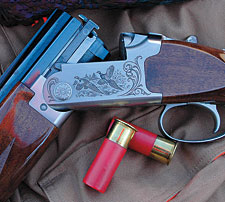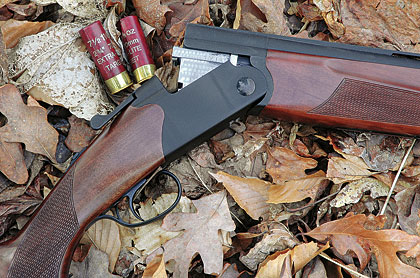They carry--and point--like a dream.
By Layne Simpson
 During a South Dakota pheasant hunt, the author alternated daily between the new Winchester 101 Light shown here and a one-pound-heavier 101 with steel receiver. He found the lighter gun to be as comfortable to shoot due to its better fit and a more efficient recoil pad. |
As a rule, a 20-gauge shotgun will weigh about a pound less than a 12-gauge gun of the same type. My 20-gauge Remington Model 1100 weighs 7-¼ pounds compared to 8-¼ pounds for my Model 1100 in 12 gauge. My old Browning Superposed in 20 gauge weighs about a pound less than the same gun in 12 gauge.
But there are exceptions to this rule, as we now have 12-gauge over/unders that are as light in the hands as 20s. We also have 20-gauge guns lighter than they have ever been, but that's another story.
Drastically reducing the weight of a stack-barrel gun is possible by making its receiver out of aluminum rather than steel. Now before you begin to fuss and fret over this metal being used in a shotgun, let me remind you that the frames of some or most successful semi-automatic handguns are made of it, and they usually last far longer than their original owners. Some auto-loading shotguns also have aluminum receivers.
Aluminum is quite suitable for use in firearms so long as it is what is described in the industry as aircraft-grade or better, and its use is restricted to parts that are not subjected to a lot of stress or strain. It works in a pistol because all parts above the aluminum frame, such as the barrel and slide, are made of steel. It works in a semi-automatic shotgun because the bolt locks into the chamber-end of a steel barrel rather than into the receiver.
When the receiver of an over/under shotgun is made of aluminum, it is reinforced with a more durable metal in two areas. One is where the standing breech supports the head of a shotshell. A steel disc slightly larger in diameter than the shotshell is inserted at the factory to prevent the possibility of battering the receiver in that area.
The other area to be reinforced is the hinge point between barrels and receiver, and this cat is commonly skinned in two ways. One is to incorporate a steel hinge pin into the design of the receiver. Another is to insert steel trunnions into the sides of the receiver for the barrel to hinge on.
One way works as well as the other, in my experience. The end result of using an aluminum receiver in a 12-gauge over/under shotgun is a reduction in weight of about a pound as compared to the same gun with a steel receiver.
 Steel reinforcements in the standing breech and hinge pin areas of the aluminum receiver of this Winchester 101 Light make it strong and durable enough for a lifetime of shooting with sensible loads. |
The Classics
I am not sure who was first to get one of these guns on the market, but the first one I hunted with was the Feather version of the Browning Cynergy. It was actually in 28 gauge and weighed only an ounce or two over five pounds. I later hunted with the 12-gauge version, and it weighed about 6-½ pounds with 26-inch barrels and a couple ounces more with 28-inch barrels.
In comparison, the steel-frame Cynergy in 12 gauge with 26-inch barrels weighs just about dead-on 7-1/2 pounds, while the 20-gauge weighs slightly less than 6-½ pounds. The 12-gauge Feather is also available with a synthetic stock and forearm and, oddly enough, it weighs the same as the gun wearing walnut.
Browning also offers its ever-popular Citori over/under with an aluminum receiver. The 12-gauge version of the standard Feather weighs about 6-¾ pounds compared to 7-¾ pounds for the steel-framed field gun. With its straight grip and trim Schnabel-style forearm, the Superlight Feather tips the scale at only 6-¼ pounds. That's about a pound less than the field gun in 20 gauge.
At six pounds, the Ultralight from Beretta is one of the lightest over/unders available. It differs from the others by having a titanium reinforcing insert in the standing breech of its receiver rather than steel. As a 12-gauge gun of such feathery heft should have, its chambers are 2-¾ inches long, so those Roman candles some hunters think they need for everything from hummingbirds to turkey gobblers are out of the question.
Not long ago, I hunted chukar in Idaho with an Ultralight and would not have wanted to use anything heavier than light target and field loads, which, by the way, cover about 95 percent of the hunting done by about 95 percent of the hunters who know how to shoot.
Then we have an old classic called the Winchester 101. I bought a brand-new one during the 1960s for $284, and it continues to see heavy use. My old gun was built entirely in Japan under Winchester's supervision, but the parts of those sold today are machined in Belgium and then shipped to Portugal for assembly.
In many ways, the old gun was a copy of the Browning Superposed, right down to its H-pattern safety slide, but the new one differs in both hinge-pin design and barrel lockup. Even so, they did an excellent job of duplicating the looks and feel of the older gun.
 With a suggested retail price of $749, the Upland Ultralight from CZ is the least expensive six-pound over-under available. |
New Versions
A recently introduced aluminum-frame version called the 101 Light weighs a pound less than its steel-frame littermate. Presently available only in 12 gauge, it has chrome-plated chambers, barrels overbored to .742 inch and 26- or 28-inch barrels replete with flush-fit interchangeable chokes. I hunted with one soon after it was introduced and found not a single nit that needed picking.
One of the latest in lightweight stack-barrel guns is the Upland Ultralight, which is made for CZ by the Turkish firm of Huglu. I have not had the opportunity to hunt with it, but I have put one through its paces at five stand, where I found it light and lively to shoot.
Like most of the competition, it weighs around six pounds in 12 gauge and comes with 26- or 28-inch barrels. This is a utility-grade gun without ejectors, whi
ch means it is not at all fancy, but it should drop birds from the sky just as efficiently as more expensive guns. I would like to see a better recoil pad on it, but who can complain when the retail price is $750.
Keep in mind that a flyweight double is a specialty gun, and it is a better choice than a standard-weight gun only for certain applications. I would not want to shoot several hundred rounds of heavy trap loads in one every day of the week, and it would not be my first choice for continued use of heavy waterfowl loads.
But it is ideal for hunting woodcock and ruffed grouse, where its lightness allows it to be easily carried muzzle-up in one hand while brush is parted with the other. It is also just the ticket for toting in chukar country and is nice to have when hunting sharptail grouse in country where you may leave many miles of tracks between dawn and dusk.
Shotgunners are usually surprised when they learn that a lightweight gun can actually be as comfortable to shoot as a heavier gun, if sensible loads are used and if it fits the shooter. Only a few weeks before writing this, I spent several days hunting pheasant in South Dakota and out of curiosity, I alternated daily between two Winchester 101s, one weighing about 6-½ pounds, the other a pound heavier.
The ammo I was shooting, Winchester Super-X loaded with 1-³â„₈ ounces of copper-plated 4s at 1,300 feet per second, is not the heaviest pheasant load available--but neither is it in the powderpuff class.
To make a short story even shorter, I found the lightweight Model 101 with its aluminum receiver to be no less comfortable to shoot than the heaver gun with a steel receiver. I admit some of the difference was in a better recoil pad on the lighter gun, but the big difference was that the light gun seemed to fit me much better than the heavier gun.






